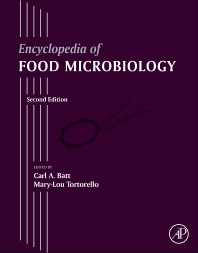LIMITED OFFER
Save 50% on book bundles
Immediately download your ebook while waiting for your print delivery. No promo code is needed.
Written by the world's leading scientists and spanning over 400 articles in three volumes, the Encyclopedia of Food Microbiology, Second Edition is a complete, highly structu… Read more

LIMITED OFFER
Immediately download your ebook while waiting for your print delivery. No promo code is needed.
Written by the world's leading scientists and spanning over 400 articles in three volumes, the Encyclopedia of Food Microbiology, Second Edition is a complete, highly structured guide to current knowledge in the field. Fully revised and updated, this encyclopedia reflects the key advances in the field since the first edition was published in 1999
The articles in this key work, heavily illustrated and fully revised since the first edition in 1999, highlight advances in areas such as genomics and food safety to bring users up-to-date on microorganisms in foods. Topics such as DNA sequencing and E. coli are particularly well covered.
With lists of further reading to help users explore topics in depth, this resource will enrich scientists at every level in academia and industry, providing fundamental information as well as explaining state-of-the-art scientific discoveries.
CB
Carl A. Batt joined the faculty in the College of Agriculture and Life Sciences at Cornell University in 1985. He is the Liberty Hyde Bailey Professor in the Department of Food Science. Prof. Batt also serves as Director of the Cornell University/Ludwig Institute for Cancer Research Partnership, he is a co-Founder of Main Street Science, and the founder of Nanooze, an on-line science magazine for kids. He is also the co-Founder and former co-Director of the Nanobiotechnology Center (NBTC) – a National Science Foundation supported Science and Technology Center. Currently he is appointed as an Adjunct Senior Scientist at the MOTE Marine Laboratory in Sarasota Florida. His research interests are a fusion of biology and nanotechnology focusing on cancer therapeutics.
Prof. Batt received his Ph.D. from Rutgers University in Food Science. He went on to do postdoctoral work at the Massachusetts Institute of Technology. Throughout his 25 years at Cornell, Prof. Batt has worked at the interface between a number of disciplines in the physical and life sciences seeking to explore the development and application of novel technologies to applied science problems. He has served as a scientific mentor for more than 50 graduates students and over 100 undergraduates, many of whom now hold significant positions in academia, government and the private sector, both in the United States and throughout the world. Partnering with the Ludwig Institute for Cancer Research, Prof. Batt has helped to establish a Good Manufacturing Practices Bioproduction facility in Stocking Hall. This facility, the only one at an academic institution in the United States, is a state-of-the-art suite of clean rooms which is producing therapeutic agents for Phase I clinical trials. One therapeutic, NY-ESO-1 is in clinical trials at New York University and Roswell Park (Buffalo, NY). A second therapeutic SM-14 is about to enter clinical trials in Brazil.
Prof. Batt has published over 220 peer-reviewed articles, book chapters and reviews. In addition, from 1987–2000 he served as editor for Food Microbiology, a peer-reviewed journal and editor for the Encyclopedia of Food Microbiology that was published in 2000. In 1998, Prof. Batt cofounded a small biotechnology research and development company, Agave BioSystems, located in Ithaca, NY and continues to serve as its Science Advisor. From 1999–2002, Prof. Batt was the President of the Board of Directors of the Ithaca Montessori School, an independent, progressive community-based school. In 2004, he co-founded Main Street Science, a not-for-profit organization to develop hands-on science learning activities to engage the minds of students.
Prof. Batt has been a champion of bringing science to the general public, especially young students, and making difficult concepts approachable. Prof. Batt is the founder and editor of Nanooze, a webzine and magazine for kids that is focused on nanotechnology and has a distribution of over 100,000 in the United States. Prof. Batt is also the creator of Chronicles of a Science Experiment which is co-produced by Earth & Sky. He headed a team that developed two traveling museum exhibitions to share the excitement of emerging technology with the general public. The first exhibition, ‘It’s a Nanoworld’ is currently on tour in the United States and has made stops including a six-month stay at Epcot in Disney World. The second exhibition, ‘Too Small to See’ began its tour at Disney World and is continuing to tour throughout the United States. More than two-million visitors have seen these exhibits. A third exhibition for long-term display at Epcot called ‘Take a Nanooze Break’ opened in February 2010 with a fourth ‘Nanooze Lab’ that opened at Disneyland in Anaheim CA in November 2011. The two Disney exhibits will reach in excess of 10M visitors each year
RR
CB